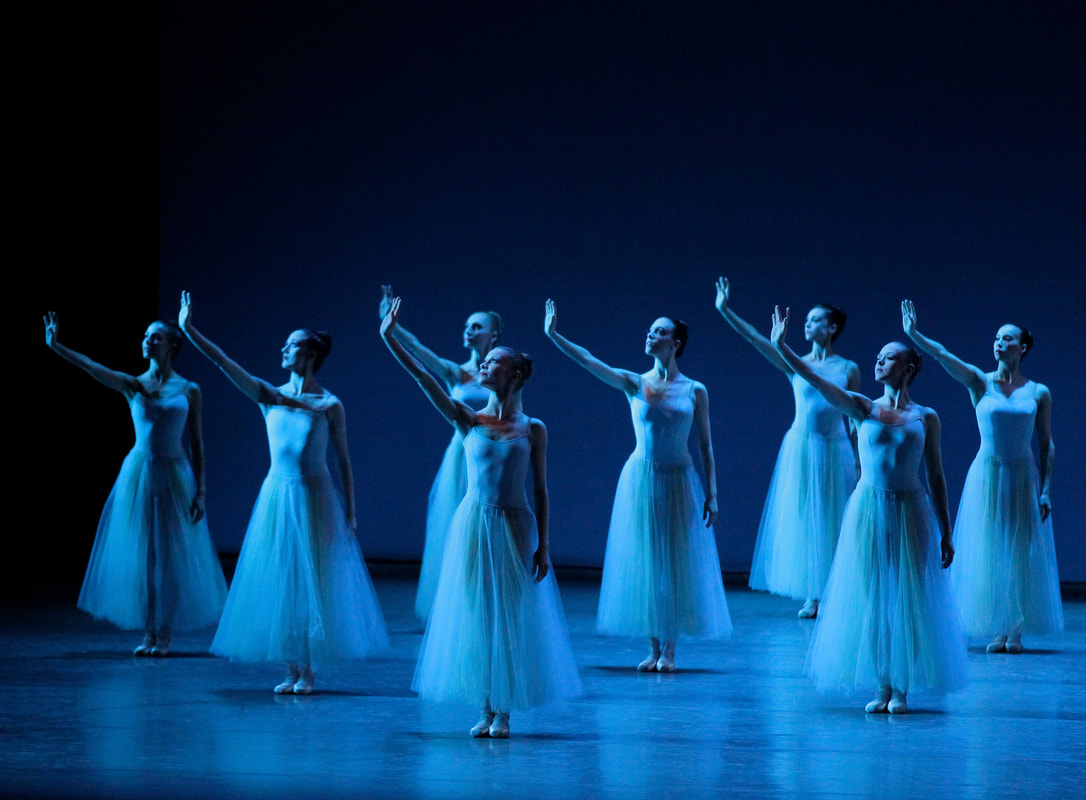|
New York City Ballet in "Serenade." There is no better pairing of a composer and choreographer than Pyotr Ilyitch Tchaikovsky and George Balanchine.
While they were not contemporaries, Balanchine devised some of his most sublime works to the soaring, romantic music of the great ballet composer. And on the top of the list is “Serenade.” The ballet was a superb opening on Tuesday night for New York City Ballet’s ever-shrinking stay at the Saratoga Performing Arts Center. It was also a wonderful welcome to the large crowd that greeted the company with cheers the moment the curtain opened. There is no doubt, Saratoga loves City Ballet and its orchestra. “Serenade” was among three ballets, “Mozartiana” and “Tchaikovsky Piano Concerto No. 2,” included, that Balanchine created to Tchaikovsky’s swelling scores – all of which were performed with gusto by the beloved City Ballet orchestra. The moving “Serenade” was the star. The all-blue ballet, with the long tutus now hinting a streak of yellow, can be a religious experience. Lauren Lovette, cast as the ballerina who ascended to the heavens, was ideal for the role. Her tiny frame lent her a vulnerability and sweetness that deepened the experience for those in the seats. Equally wonderful was Ask LaCour has her fleeting suitor and Preston Chamblee, as the blind angel of death. But what makes this ballet so wonderful, is its iconic opening tableau – a bevy of ballerinas with their palms pressed to the sky and then their arms melting over the heads just before their feet flick to first position. The ending is equally memorable -- a ballerina, in this case Lovette, is touched by the angel whom she dances with before she collapses. The ballerina is then lifted by her ankles and arches her back, chest to the sky, as if surrendering her soul to something larger. Balanchine created the ballet in 1935, his first in America. It appears he poured all his knew about ballet and Tchaikovsky into it and it will surely be a treasure for decades to come. “Tchaikovsky Piano Concerto No. 2” was almost as wonderful. Susan Walters fiercely attacked the score on the piano while the dancers surged and scattered in large intriguing patterns – the kinds of designs that only Balanchine could create. Teresa Reichlen and Russell Janzen held sway as the princess and her dreamy suitor. So too did Lauren King who lit up the stage with her posse, Sara Adams and Indiana Woodward. For such a formal work, with many bent-kneed proposals, Balanchine kept the dancers moving and moving quickly through to a finish that sparkled. “Mozartiana,” which is also ceremonial, was a little disappointing. The opener, Preghiera, with the young ballerinas and prayerful Sara Mearns was gorgeous. As usual, Daniel Ulbricht was a dynamo in the Gigue. But the Theme et Variations with Mearns and Tyler Angle looked belabored. Mearns can do anything, but looks her best as an adagio dancer. Angle was fine, hitting the complicated entrechat, but appeared overly winded at the end. The young local students, Amelia Blackwood, Eliana Lomanno, Julia Ross and Avery Walz, were perfection, just like the rest of the evening. Welcome back New York City Ballet.
0 Comments
Leave a Reply. |
Wendy
|

 RSS Feed
RSS Feed
